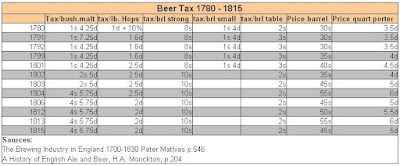 Yes, you've guessed, I switched periods again. I'm back to those crucial decades around 1800, when the foundation of later brewing practices was laid.
Yes, you've guessed, I switched periods again. I'm back to those crucial decades around 1800, when the foundation of later brewing practices was laid.The doubling of the price of malt in the first decade of the 19th century puts into perspective the current rise in the price of raw materials.
Expansion
The scale of brewing in London was transformed during the second half of the 18th century. In 1750, the largest London brewery produced fewer than 60,000 barrels annually. By 1800 five were brewing more than 100,000 barrels. In 1815 London's - and also the world's - largest brewery, Barclay Perkins, was churning out 337,000 barrels a year, an enormous quantity for the period.

 Taxation
TaxationThe latter years of the 18th century held plenty of challenges for the brewing industry. Particulalrly the war with France, which stretched over more than two decades and put considerable strain on Britain's finances. As usual, taxing brewing was an easy way to raise revenue.
Beer was double taxed. Firstly, there was a tax on the raw materials, malt and hops. There was also a tax on beer, a fixed amount per barrel. This had three rates, one for Small Beer or Ale, one for Table Beer or Ale and one for Strong Beer or Ale. Which band applied was determined by the retail price. Anything retailing at more than 11 shillings a barrel was counted as Strong, anything below 6 shillings Small and between was Table. In 1802 the Small category was combined with Table. Over 16 shillings a barrel was Strong, below 16 shillings Table.
Between 1780 and 1815, malt tax more than tripled, rising from 1s 4.25d (16.25d) to 4s 5.75d (53.75d). The rise in tax on hops was much more modest, 1d + 10% to 2d, as was the increas in the flat rate tax per barrel, 8 shillings to 10 shillings.

The effect was a dramatic increase in price brewers had to pay for their malt. The average price of malt in the period 1809-1817 was more than double what it had been 1779-1789.

After 1804, almost half of the price of a quarter of malt was tax. 4s 5.75d tax a bushel works out to 35s 10d tax a quarter, for which brewers were paying around 80 shillings.
Brewers had a massive incentive to reduce their malt usage. As you'll see later, they did the obvious thing and reduced gravities. But new technologies, in particular the hydrometer, allowed them to also use a more scientific approach to cutting down the amount of malt they required. A direct result was a move to using pale malt as the base for all Beers and Ales.











































































No comments:
Post a Comment